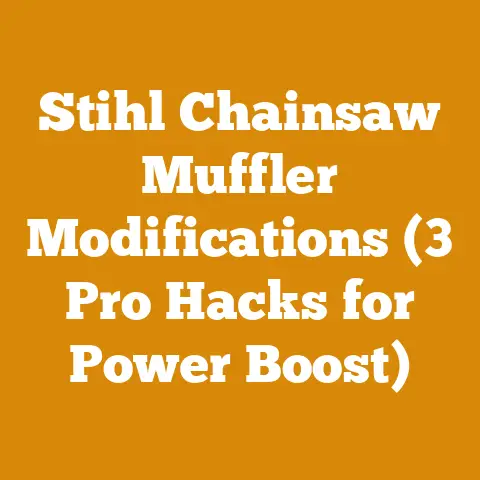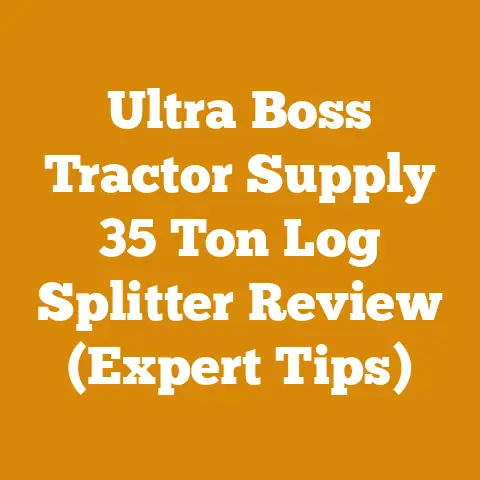Stump Cutting Tips: Flush Lawn Removal Techniques (Pro Guide)
Have you ever stared at an ugly tree stump in your yard, feeling like it’s mocking your landscaping efforts? I know I have! It’s a common problem, and one that I’ve tackled countless times over the years. That’s why I’m going to share my best stump-cutting tips for flush lawn removal.
Why Remove a Tree Stump Flush?
Before diving into the how-to, let’s consider the “why.” A stump left in your yard can lead to several issues.
- Aesthetic Issues: Stumps are unsightly and detract from the overall appearance of your lawn.
- Safety Hazards: They can be tripping hazards, especially for children and the elderly.
- Pest Attraction: Decaying wood attracts insects like termites and ants.
- Root Sprouts: Some trees send up new shoots from the remaining roots, creating new unwanted trees.
- Lawn Maintenance: Stumps make mowing and other lawn care activities difficult.
Understanding the Options
There are several methods for removing tree stumps, each with its pros and cons. The best method depends on the size of the stump, your budget, the tools you have available, and your physical capabilities.
- Manual Removal: Digging and chopping the stump out by hand.
- Chemical Removal: Using chemicals to accelerate the decomposition of the stump.
- Stump Grinding: Using a machine to grind the stump into small chips.
- Burning: Burning the stump (where permitted and safe).
For the purpose of this guide, I will focus on manual removal and stump grinding, as these are the most common and practical methods for achieving a flush lawn removal.
Method 1: Manual Removal
Manual removal is the most labor-intensive method, but it’s also the most environmentally friendly and doesn’t require specialized equipment (beyond what many homeowners already own).
Assessing the Stump
Before you start, take a good look at the stump. Consider these factors:
- Size: How large is the stump in diameter and how far do the roots extend?
- Type of Tree: Some trees have shallow root systems while others have deep taproots.
- Soil Type: Is the soil loose and sandy or compact and clayey?
These factors will influence the tools you need and the amount of effort required.
Tools Needed
- Shovel: For digging around the stump and roots.
- Mattock or Pickaxe: For breaking up soil and cutting through roots.
- Axe or Hatchet: For chopping through roots.
- Bow Saw or Reciprocating Saw: For cutting larger roots.
- Loppers or Pruning Shears: For smaller roots.
- Gloves: To protect your hands.
- Safety Glasses: To protect your eyes.
- Wheelbarrow: For hauling away soil and debris.
- Leverage Bar (Optional): For prying the stump loose.
Step-by-Step Guide to Manual Stump Removal
-
Clear the Area: Remove any rocks, debris, or vegetation around the stump.
-
Dig Around the Stump: Use the shovel to dig a circle around the stump, exposing the main roots. The diameter of the circle will depend on the size of the stump, but aim for at least 2-3 feet.
-
Expose the Roots: Carefully remove the soil from around the roots. Use the mattock or pickaxe to break up compacted soil.
-
Cut the Roots: Use the axe, hatchet, bow saw, or reciprocating saw to cut through the exposed roots. Start with the smaller roots and work your way up to the larger ones.
- Pro Tip: A reciprocating saw with a demolition blade is excellent for cutting through roots, especially if they are partially buried in soil. The blade can handle some dirt without dulling too quickly.
-
Loosen the Stump: Once you’ve cut through most of the roots, try to rock the stump back and forth. Use the leverage bar if needed to help loosen it.
-
Cut the Taproot (If Applicable): Some trees have a large taproot that extends deep into the ground. If you encounter a taproot, you’ll need to cut it as close to the stump as possible. This may require digging deeper and using a longer saw.
-
Remove the Stump: Once the stump is free, lift it out of the hole. You may need help with larger stumps.
-
Fill the Hole: Fill the hole with topsoil and compact it. You can then re-seed or sod the area.
Dealing with Difficult Roots
Sometimes, you’ll encounter roots that are too thick or too deeply buried to cut easily. Here are some tips for dealing with difficult roots:
- Use a Root Saw: A root saw is a specialized tool designed for cutting through thick roots. It has a long, flexible blade that can reach roots in tight spaces.
- Dig Deeper: If the root is too deeply buried to cut, dig deeper around it. This will give you more room to work and allow you to get a better angle on the cut.
- Use Water: If the soil is very hard and dry, try soaking it with water. This will soften the soil and make it easier to dig and cut through the roots.
- Cut at an Angle: Cutting roots at an angle can sometimes make it easier to sever them.
Manual Removal: Case Study
I once helped a friend remove a large oak stump from his yard. The stump was about 2 feet in diameter and had a network of thick, gnarled roots. We spent an entire weekend digging, chopping, and sawing, but we eventually got the stump out. The key was patience and persistence. We used a combination of an axe, a reciprocating saw, and a root saw. The root saw was particularly helpful for cutting through the thick, deeply buried roots. In the end, we were both exhausted, but we were also proud of our accomplishment.
Takeaway: Manual removal is a viable option for smaller stumps or when you want to avoid using machinery or chemicals. Be prepared for a physically demanding task.
Method 2: Stump Grinding
Stump grinding is a faster and less labor-intensive method than manual removal. It involves using a specialized machine to grind the stump into small chips.
Understanding Stump Grinders
A stump grinder is a powerful machine with a rotating cutting wheel equipped with teeth. The wheel is used to grind the stump into small pieces, typically to a depth of 4-6 inches below the ground surface.
There are two main types of stump grinders:
- Walk-Behind Stump Grinders: These are smaller, more maneuverable machines that are suitable for residential use. They typically have engines ranging from 13 to 25 horsepower.
- Tow-Behind Stump Grinders: These are larger, more powerful machines that are suitable for commercial use. They typically have engines ranging from 25 to 50 horsepower.
Renting vs.
- Renting: Renting a stump grinder can be a cost-effective option if you have several stumps to remove or if you enjoy doing DIY projects. However, it requires some skill and experience to operate the machine safely and effectively. Rental rates typically range from \$100 to \$300 per day, depending on the size and type of machine.
- Hiring a Professional: Hiring a professional stump grinding service is the easiest and safest option, especially if you have a large or difficult stump to remove. Professionals have the experience and equipment to get the job done quickly and efficiently. The cost of hiring a professional typically ranges from \$2 to \$5 per inch of stump diameter.
I recommend hiring a professional if you’ve never used a stump grinder before or if you’re not comfortable operating heavy machinery. Safety should always be your top priority.
Safety Precautions
Stump grinding is a potentially dangerous activity. It’s essential to take the following safety precautions:
- Wear Safety Glasses: Always wear safety glasses to protect your eyes from flying debris.
- Wear Hearing Protection: Stump grinders are very loud. Wear earplugs or earmuffs to protect your hearing.
- Wear Gloves: Wear gloves to protect your hands from splinters and cuts.
- Wear Long Pants and Long Sleeves: Wear long pants and long sleeves to protect your skin from flying debris.
- Wear Steel-Toed Boots: Wear steel-toed boots to protect your feet.
- Clear the Area: Clear the area around the stump of any rocks, debris, or vegetation.
- Keep Bystanders Away: Keep bystanders, especially children and pets, at a safe distance from the stump grinder.
- Read the Operator’s Manual: Before operating the stump grinder, read the operator’s manual carefully and follow all instructions.
- Inspect the Machine: Inspect the stump grinder before each use to ensure that it is in good working order. Check the teeth on the cutting wheel for wear and damage.
- Be Aware of Underground Utilities: Before grinding, contact your local utility companies to locate any underground utilities in the area.
- Never Operate the Machine Under the Influence of Drugs or Alcohol: This should be obvious, but it’s worth repeating.
- Take Breaks: Stump grinding can be physically demanding. Take frequent breaks to avoid fatigue.
Step-by-Step Guide to Stump Grinding
-
Prepare the Stump: Clear the area around the stump of any rocks, debris, or vegetation. Cut the stump as close to the ground as possible with a chainsaw.
- Pro Tip: Consider using a chainsaw with a carbide-tipped chain. These chains are more resistant to dulling when cutting near the ground, where the chain is more likely to come into contact with dirt and rocks.
-
Position the Stump Grinder: Position the stump grinder so that the cutting wheel is directly over the stump.
-
Start the Engine: Start the engine and allow it to warm up.
-
Engage the Cutting Wheel: Engage the cutting wheel and slowly lower it onto the stump.
-
Grind the Stump: Move the cutting wheel back and forth across the stump, grinding it into small chips.
-
Adjust the Depth: As you grind, adjust the depth of the cutting wheel to gradually remove the stump. Aim to grind the stump to a depth of 4-6 inches below the ground surface.
-
Grind the Roots: Once you’ve ground the main part of the stump, grind any exposed roots that extend beyond the perimeter of the stump.
-
Fill the Hole: Fill the hole with the stump grindings and topsoil. Compact the soil and re-seed or sod the area.
Stump Grinding: Case Study
I once rented a stump grinder to remove several small stumps from my yard after removing some overgrown bushes. The stumps were only about 6-8 inches in diameter, but there were about a dozen of them. Renting the stump grinder was much faster and easier than trying to remove them manually. I was able to grind all of the stumps in a single afternoon. The key was to take my time and follow the safety precautions. I wore safety glasses, hearing protection, gloves, and steel-toed boots. I also made sure to clear the area around each stump of any rocks or debris.
Takeaway: Stump grinding is a fast and efficient method for removing stumps, but it’s essential to take safety precautions and follow the manufacturer’s instructions.
Dealing with Large Stumps
Grinding a large stump can be a time-consuming process. Here are some tips for dealing with large stumps:
- Make Multiple Passes: Instead of trying to grind the entire stump in one pass, make multiple passes, gradually removing layers of wood.
- Grind in a Circular Pattern: Grind the stump in a circular pattern, working your way from the outside to the center.
- Adjust the Grinding Angle: Adjust the grinding angle to maximize the efficiency of the cutting wheel.
- Take Breaks: Take frequent breaks to avoid fatigue.
After Grinding
After grinding the stump, it’s important to properly fill the hole and prepare the area for planting.
- Remove Excess Grindings: Remove any excess stump grindings from the hole.
- Mix Grindings with Soil: Mix the remaining stump grindings with topsoil to create a nutrient-rich soil mixture.
- Fill the Hole: Fill the hole with the soil mixture and compact it.
- Re-seed or Sod: Re-seed or sod the area to restore the lawn.
Alternative Stump Removal Methods
While manual removal and stump grinding are the most common methods, here are a few alternative options:
- Chemical Removal: This involves using a chemical stump remover to accelerate the decomposition of the stump. This method can take several months or even years to completely remove the stump.
- Burning: Burning the stump is a fast and effective method, but it is not permitted in all areas. Check your local regulations before attempting to burn a stump.
- Natural Decomposition: Simply letting the stump decompose naturally. This can take many years, but it requires no effort on your part.
Understanding Wood Decomposition
Regardless of the method you choose, understanding the basics of wood decomposition can be helpful. Wood is primarily composed of cellulose, hemicellulose, and lignin. Microorganisms, such as fungi and bacteria, break down these components over time.
- Cellulose and Hemicellulose: These are the easiest components to break down.
- Lignin: This is a complex polymer that provides structural support to the wood. It is more resistant to decomposition than cellulose and hemicellulose.
Factors that affect the rate of wood decomposition include:
- Moisture: Moisture is essential for microbial activity.
- Temperature: Warm temperatures promote faster decomposition.
- Oxygen: Oxygen is required for aerobic decomposition.
- Nutrients: Microorganisms need nutrients to thrive.
- Wood Species: Some wood species are more resistant to decay than others.
Environmental Considerations
When removing a tree stump, it’s important to consider the environmental impact.
- Soil Erosion: Digging around the stump can disturb the soil and lead to erosion. Take steps to minimize soil erosion, such as using erosion control blankets or planting ground cover.
- Chemical Use: Avoid using harsh chemicals that can harm the environment. If you use a chemical stump remover, choose a product that is biodegradable and environmentally friendly.
- Waste Disposal: Dispose of the stump and root debris properly. Consider composting the wood chips or using them as mulch.
Maintaining Your Lawn After Stump Removal
After removing the stump, it’s important to properly maintain your lawn to ensure that it recovers quickly.
- Soil Testing: Test the soil to determine if it needs any amendments.
- Fertilizing: Fertilize the lawn to promote healthy growth.
- Watering: Water the lawn regularly, especially during dry periods.
- Weed Control: Control weeds to prevent them from competing with the grass.
- Mowing: Mow the lawn regularly to maintain a healthy height.
Common Mistakes to Avoid
- Not Assessing the Stump Properly: Failing to assess the size, type, and location of the stump before starting the removal process.
- Using the Wrong Tools: Using the wrong tools for the job can make the process more difficult and time-consuming.
- Not Taking Safety Precautions: Failing to take safety precautions can lead to serious injuries.
- Not Digging Deep Enough: Not digging deep enough around the stump can make it difficult to cut the roots.
- Not Cutting All the Roots: Not cutting all the roots can prevent you from removing the stump.
- Not Filling the Hole Properly: Not filling the hole properly can lead to settling and drainage problems.
- Not Maintaining the Lawn After Removal: Failing to maintain the lawn after removal can prevent it from recovering quickly.
Stump Cutting Tips: Advanced Techniques
For those seeking to refine their stump removal skills, here are some advanced techniques:
- Using a Chainsaw Mill: For very large stumps, a chainsaw mill can be used to cut the stump into manageable pieces. This involves attaching a milling attachment to your chainsaw to create planks or slabs.
- Hydraulic Stump Puller: These are powerful machines designed to pull stumps directly out of the ground. They are typically used for large-scale land clearing projects.
- Explosives: In some cases, explosives can be used to remove stumps. However, this method is extremely dangerous and should only be attempted by trained professionals.
The Future of Stump Removal
The field of stump removal is constantly evolving. New technologies and techniques are being developed all the time. Some emerging trends include:
- Robotic Stump Grinders: These are autonomous machines that can grind stumps without human intervention.
- Bio-degradable Stump Removal Products: These are environmentally friendly products that accelerate the decomposition of stumps without harming the environment.
- Drone-Based Stump Inspection: Drones can be used to inspect stumps and assess their size and location.
Conclusion
Removing a tree stump flush with the lawn can be a challenging but rewarding task. By understanding the different methods, tools, and safety precautions, you can effectively and safely remove stumps from your yard. Whether you choose manual removal, stump grinding, or another method, remember to take your time, follow the instructions, and prioritize safety. With a little patience and effort, you can reclaim your lawn and enjoy a stump-free landscape.






